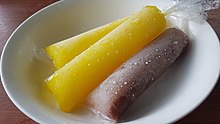Freezie
  Top: A blue raspberry
flavored freezie from the United States Bottom: Home-made pineapple and chocolate-flavored ice candy from the Philippines | |
| Alternative names | Freeze pop, freezer pop, ice pole, icy pole, sip up, ice candy cool pop |
|---|---|
| Type | Frozen dessert |
| Place of origin | United States |
| Main ingredients | Water, flavouring (such as fruit juices) |
A freezie or a freeze pop is a water-based frozen confection similar to an ice pop. It is made by freezing flavored liquid such as sugar water, fruit juice or purée inside a plastic casing or tube, either round or flat. Freezies come in sealed plastic tubular wrappers and conform to the shape of the wrapper when frozen to serve; as such, they do not need to be stored cold. They also do not need to be frozen as solidly as an ice pop and can have a consistency similar to that of a slushie. Freezies are sold in a variety of flavors, including cherry, orange, lemon-lime, watermelon, cream soda, blue raspberry and grape.
Name
[edit]Freezies go by a variety of different names in different regions. The name freezie itself is most commonly used in Canada.[1] Other regional names include freeze pop, freezer pop and Icee in the United States,[2] ice pole and ice pop in the United Kingdom,[3] icy pole in Australia,[4] sip up and Pepsi ice in India,[5] penna-cool in Trinidad and ice candy in the Philippines.[6] Names used in non-English speaking countries include bolis in Mexico and Colombia,[7] polo flash in Spain, chup[8] or marciano in Peru,[9] chup-chup, sacolé, dindim and geladinho in Brazil,[10] shlukim (Hebrew: שלוקים) in Israel,[11] and aiskrim Malaysia in Malaysia.[12]
The name of the prominent brand of freezies is also commonly used as a generic term for freezies in the region. Examples include Otter Pops, Fla-Vor-Ice and Pop-Ice in the United States,[13] Zooper Dooper in Australia,[4] and Mr. Freeze in the United Kingdom and Canada.[3]
History
[edit]The first brand to introduce the concept of freezies to the United States was Pop-Ice, which was acquired by Jel Sert in 1963.[14] six years later in 1969, Jel Sert launched its own brand of freezies called Fla-Vor-Ice, which quickly gained popularity and became the company's best-selling brand.[2] Otter Pops was founded in the 1970s and grew to dominate the west coast freezie market. In 1996, the company was acquired by Jel Sert, making Jel Sert the largest supplier of freezies in the United States.[2]
In Canada, freezies have been made by Kisko under the Mr. Freeze brand since 1977 when the company started producing them in the Toronto region after the business was relocated from Kingston, Jamaica.[15] In the UK and Ireland, an unrelated brand called Mr. Freeze has been sold since 1966.[16]
Brands
[edit]The freezies market is composed of many prominent regional brands with no brands having a large global reach. In the United States, prominent brands of freezies include Fla-Vor-Ice, Otter Pops, Pop-Ice, all three of which are made by Jel Sert.[2] Other prominent brands include Mr. Freeze, produced by Kisko, in Canada,[15] the unrelated Mr. Freeze produced by Calypso Soft Drinks Ltd in the British Isles,[17] Zooper Dooper in Australia,[2] Bon Ice in Mexico, Calippo in the British Isles and Australasia and Polaretti in Italy.[2]
References
[edit]- ^ Hopper, Tristin (26 December 2013). "From 'toque' to 'mickey,' ten Canadianisms that leave other English speakers utterly confused". National Post. Retrieved 17 April 2021.
- ^ a b c d e f Fontevecchia, Veruska (21 August 2018). "Why Millennials Are the New Target Audience for Freeze Pops". Eater. Retrieved 17 April 2021.
- ^ a b "Ice pops… or freezies? Debate over the CORRECT name goes viral". News Need News. 26 June 2018. Retrieved 8 October 2021.
- "ice pop". Cambridge Dictionary. Retrieved 9 October 2021. - ^ a b "Americans Apparently Just Found Out What Zooper Doopers Are & They're Freaking The Fuck Out". Pedestrian TV. 16 June 2020. Retrieved 17 April 2021.
- ^ "Sipup packing machine Choco stick packing machine". Retrieved 10 July 2021 – via YouTube.
- "Indian pepsi ice recipe, How to make pepsi ice recipe". Sharmis Passions. 22 April 2017. Retrieved 21 April 2022.
= "Childhood Foods That'll Always Be Close To Our Hearts | BeBEAUTIFUL". Be Beautiful India. 30 April 2015. Retrieved 21 April 2022. - ^ "Munggo ice candy". Ang Sarap. 27 June 2012. Retrieved 31 December 2013.
- ^ "Bolis Icesticks - Ice Pops / Helados Assorted Flavors". mexgrocer.com. Retrieved 17 April 2021.
- ^ "Chups – Diversión de Verano". Peru Delights. 11 June 2014.
- ^ "Mercado libre". Marcianos Por Mayor. Retrieved 17 April 2021.
- ^ Culinária, Receita (10 October 2020). "UMA ÓTIMA OPÇÃO PARA ESSE CALOR | FAÇA E VENDA GELADINHO CREMOSO /CHUP-CHUP-SACOLÉ OU TICOLÉ | Receita Culinária" (in Brazilian Portuguese). Retrieved 17 April 2021.
- "Ice pop bags - Geladinho / Sacolé". Doucerie | Confectionery, Baking & Party Supplies. Archived from the original on 16 May 2021. Retrieved 17 April 2021. - ^ Maidenberg, Jen (6 November 2012). "What comes after bliss". Arizona Jewish Post. Jewish Federation of Southern Arizona. Retrieved 22 June 2022.
- ^ "Go down memory lane eating 'Aiskrim Malaysia' while learning about oral care". The Star. 15 May 2012. Retrieved 23 March 2013.
- ^ "A freezer pop by any other name will definitely taste as sweet". NBC News. Retrieved 17 April 2021.
- ^ "Our History". Jelsert. Archived from the original on 24 January 2021. Retrieved 8 October 2021.
- ^ a b Cheung, Jessica (29 July 2017). "Kisko Freezies celebrates 40 years in the business by building a school in Jamaica, where the company started". CBC News.
- ^ "Mr. Freeze reports good March Sales". Talking Retail. 18 May 2012.
- ^ "Mr Freeze unveils limited edition bulk box". Talking Retail. 15 May 2014.
